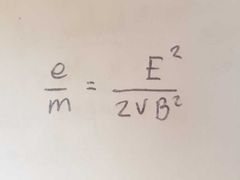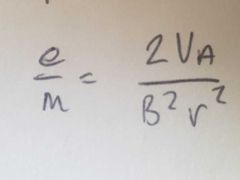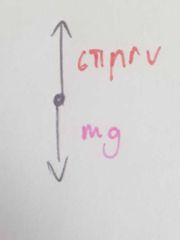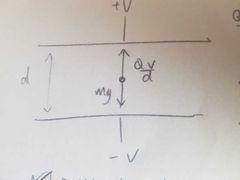![]()
![]()
![]()
Use LEFT and RIGHT arrow keys to navigate between flashcards;
Use UP and DOWN arrow keys to flip the card;
H to show hint;
A reads text to speech;
71 Cards in this Set
- Front
- Back
|
What is a discharge tube? |
tube with low pressure gas anode at one end cathode at other |
|
|
What observation lead to cathode rays? |
pressure in discharge tube reduced anode glowed |
|
|
Nature of cathode rays? hypothesis and conclusion |
charged particles(with mass) rays could be deflected in electric and magnetic fields |
|
|
How are cathode rays produced? (5) |
high PD causes ionization of gas atoms +ve ions accelerate towards cathode e accelerate towards anode e collide with gas, ionizing or exciting de-excitation causes visible/UV emission |
|
|
Thermionic emission? |
the release of electrons from a heated source |
|
|
what is the work function of a metal? |
minimum energy required to remove a delocalised electron from surface of metal |
|
|
what happens when a cathode is electrically heated? |
some electrons gain enough thermal energy to overcome attractive forces in metal escape surface |
|
|
what is a CRT |
cathode ray tube evacuated tube containing an electron gun creates high speed electron beam |
|
|
what is the work done by the gun on individual electrons? |
eV |
|
|
what happens when you increase PD across anode-cathode in gun? |
increase in electron speed |
|
|
what happens when you increase the current in the cathode in E-gun? |
higher electron intensity more electrons per second |
|
|
Funding specific charge of electron using helmholtz coils? |
E field and M field deflect electrons in opposite directions when fluorescent screen straight line :. forces balanced |
|
|
calculating specific charge of electron from balanced field method? |

electric field strength, PD, flux density |
|
|
What is a fine beam tube? |
electron gun + helmholtz coils creates circular electron pattern on fluorescent screen |
|
|
how to calculate specific charge of electron from fine beam tube? |

accelerating voltage of gun flux density radius of path |
|
|
Significance of Thompson's experiments? |
charged couldn't be separated from particles :. not EM wave deflection direction :. -ve charge charge:mass for all particles same :. particle property not equipment cathode ray C/kg >> hydrogen ion :. atoms not smallest matter |
|
|
What are the 2 forces on a free falling oil droplet? |

mg drag due to viscosity of air |
|
|
How did Millikans oil drop experiment work? (5) |
•atomizer produce cloud of droplets •some fall through anode pinhole •x-rays ionise drops •measure v using microscope •adjust electric field until stationary |
|
|
How did millikan calculate the mass of the droplet? |
stokes law + mg to give radius density + volume to give mass |
|
|
2 forces on charged oil droplet under electric field? |

|
|
|
What was Millikan's conclusion? |
Q was always multiples of 1.6e-19 :. charge does not exist in quantities less than this :. must be magnitude of charge of electron |
|
|
What was Newton's corpuscular theory of light? (4) |
•made up of coloured corpuscules (red more massive) •reflection - vy reversed by repulsive force of medium •refraction - vy increased by attractive force (bending towards medium) •light travels faster in media |
|
|
What was Huygen's wave theory? |
•light longutudual wave, medium -> aether •movement via propagation of wavefronts •explained reflection, refraction and dispersion •light moves slower in media |
|
|
Strengths of corpuscular theory? |
•can explain sharp shadows •Newton more credible than Huygen |
|
|
Why was wave theory accepted? |
•can explain diffraction •Fizeau and Focault measured light speed in air and water:. slower in water :. contradictory to corpuscular |
|
|
What did corpuscular theory predict @ young's double slit? |
two bright fringes |
|
|
Why do fringes form in young's double slit? |
phase difference = 180° path difference = (n+0.5)wavelength destructive interference |
|
|
What was Fizeau's speed of light experiment? |
•rotating toothed wheel •light split into bursts when returning •at specific frequency, light completely blocked by adjacent tooth on return |
|
|
Equation for time to turn through one tooth? |
t = T/2N T = time period of wheel N = number of teeth |
|
|
What was Maxwell's hypothesis? |
EM radiation propagates as a wave of oscillating electric and magnetic fields at right angles to eachother |
|
|
What did Maxwell predict about an oscillating charge? |
it could produce an oscillating magnetic field :. creating an oscillating electric field |
|
|
What did Hertz discover ? |
Radio waves |
|
|
What was Hertz's experiment? |
•induction coil produced high PD across spark gap •spark :. moving charge :. radio wave produced •wave induced emf in copper wire detector |
|
|
What did Hertz observe? |
•waves generated would be absorbed by metal plate •increased intensity by reflecting waves back at loop using parabolic reflect behind detector |
|
|
How did Hertz calculate c? |
•using loop, measured positions of nodes and antinodes (wavelength) •used frequency of wave generator as frequency •speed ~ Maxwell's prediction |
|
|
What did Hertz prove? |
light is an EM wave light can be polarised |
|
|
what happens when the receiving loop is perpendicular to the antenna? |
no spark created no emf induced in loop |
|
|
What is the ultraviolet catastrophe? |
•classical wave theory - energy emitted by black body continue to increase as wavelength decreases •experimental values did not show this |
|
|
What is a black-body? |
Theoretical object that absorbs/emits all radiation incident on it. |
|
|
When was the first observation of photoelectricity ? |
•Hertz radio waves experiment •receiver put in darken box to see more clearly •reduced spark length :. less electrons due to no UV incident |
|
|
Rate of photoemission is proportional to... |
the intensity of light incident |
|
|
What did classical wave theory predict about the photoelectric effect? |
•no thershold f :. energy would build up •delay between incident and emission •intensity proportional to max KE |
|
|
What is a photon? |
a quantum of electromagnetic radiation (Einstein) |
|
|
How was Planck's constant measured? |
•light incident on photocell •potential divider makes emitter plate increasingly positive •electrons must do work to overcome attraction • eVs = hf - work function
|
|
|
How are charged particles produced in discharge tube? |
•ionization by collision •electrons pulled out of gas •ions hit cathode, freeing electrons |
|
|
Why does a discharge tube have to be a low pressure? |
particles need to be widely spread ions and electrons would be stopped by gas particles |
|
|
Why does the gas in discharge tubes emit light? |
•electrons collide with opposite moving ions and excite them •ions de-excitate and release visible/UV photons |
|
|
Why do electrons move in a circular path at constant speed in a magnetic field? |
•force is perpendicular to velocity •no work done on e- by force :. KE constant •force constant as speed constant •F always perpendicular to v :. centripetal |
|
|
De brogile hypothesis? |
all matter can act as a wave wavelength based on momentum of matter |
|
|
What is electron diffraction? |
•E-gun @ uniform speed @ metal foil •each plane of atoms in foil act like diffraction grating •constructive interference :. bright rings |
|
|
What is the effect on the rings when anode potential is increased? |
•increased voltage :. increased momentum :. decreased wavelength •smaller wavelength diffracts less :. smaller rings |
|
|
What is wave-particle duality? |
term used to describe behaviours of quantum scale objects having both wave and particle like properties |
|
|
What is resolving power? |
ability of an optical instrument to distinguish between two features close together on an object under examination |
|
|
the shorter the wavelength of the microscope the... |
greater the resolving power |
|
|
Why are electrons used instead of photons in a microscope? |
•electrons can be accelerated to very high momentum •wavelength of high momentum electrons << light •higher resolving power |
|
|
How does a transmission electron microscope work?(5) |
•electron gun -> condenser lens •scatter as interact with thin specimen •inverted by objective lens •magnified by magnified lens (uninverted) •projected onto fluorescent screen/electron detector |
|
|
What causes the pattern in Michelson-Morley experiment? |
phase difference of two beams |
|
|
What happens to electrons that pass through edge of magnetic lens? |
maximum deflection |
|
|
What happens to electrons that pass through middle of lens? |
nothing not affected |
|
|
What is the minimum wavelength that can resolve an atom? |
0.1nm |
|
|
How does a Scanning Tunneling Microscope work? |
•+ve probe tip held close to surface of specimen •close enough electrons can quantum tunnel across gap •closer tip :. higher probability of tunneling :. higher current |
|
|
2 STM modes? |
•constant current mode: tip moved to keep current constant, movement mapped as peak/troughs of specimen •constant height mode: tip kept at a height, changes in current used as height map of specimen |
|
|
What did the Michelson-Morley experiment set out to measure? |
the absolute speed of the earth relative to the aether |
|
|
two postulates? |
physical laws have the same form in all initial frames of motion speed of light in a vacuum is invariant |
|
|
a clock moving relative to an observer would appear to run.. |
more slowly |
|
|
t0 ? |
time observed by observer, proper time |
|
|
l0 ? |
length as observed by observer contracts more as object approaches c |
|
|
How do so many muons make it to earth? |
time passes more slowly for muons as they travel very close to c lengthening their half lives |
|
|
Why can no object reach the speed of light? |
mass becomes infinitely large :. would take infinite energy to accelerate |
|
|
Energy for particle accelerated close to speed of light? |
= m0c^2 + QV |
|
|
Why do electrons go from surface to tip? |
wave like nature small probability electron tunnels across gap only from -ve to +ve |

